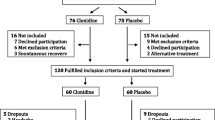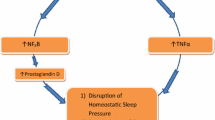Abstract
Past studies have shown that severe fatigue was the presenting symptom in six of seven patients with delayed orthostatic hypotension and that tilt table-induced hypotension was found in 22 of 23 patients with the chronic fatigue syndrome. We have determined the prevalence of fatigue, volunteered in response to a nonspecific pre-examination questionnaire used in 431 patients, each subsequently diagnosed as having one of eight neurological or endocrine disorders. The results show that fatigue is a very common symptom in patients with delayed orthostatic hypotension (n=21), as well as both primary (n=30) and secondary (n=106) hypocortisolism: 70–83% in all groups. In contrast, fatigue was an uncommon complaint in patients with multiple system atrophy (MSA) (n=30), pituitary dosorders without hypocortisolism (n=106) or idiopathic hirsutism (n=96): 7–33% in all groups, and was intermediate in prevalence in patients with acute hyperadrenergic orthostatic hypotension (n=32): 41%. It is concluded that fatigue commonly results from delayed orthostatic hypotension and all forms of hypocortisolism but is less common in patients with acute orthostatic hypotension, both idiopathic and due to MSA, which more commonly present with lightheadedness or syncope.
Similar content being viewed by others
References
Bradbury S, Eggleston C. Postural hypotension. Report of three cases.Am Heart J 1925;1:73–86.
Bannister R, Ardill L, Fentem P. Defective autonomic control of blood vessels in idiopathic orthostatic hypotension.Brain 1967;90:725–746.
Thomas JE, Schirger A. Idiopathic orthostatic hypotension. A study of its natural history in 57 neurologically affected patients.Arch Neurol 1970;22:289–293.
Cryer PE, Silverberg AB, Santiago JV, Shah SD. Plasma catecholamines in diabetes. The syndromes of hypoadrenergic and hyperadrenergic postural hypotension.Am J Med 1978;64:407–416.
Mann S, Altman DG, Raftery EB, Bannister R. Circadian variation of blood pressure in autonomic failure.Circulation 1983;68:477–483.
Bradshaw MJ, Edwards RTM. Postural hypotension — pathophysiology and management.Q J Med 1986;231:643–657.
Streeten DHP.Orthostatic disorders of the circulation. New York: Plenum; 1987; p. 115.
Jansen RWMM, Lipsitz LA. Postprandial hypotension: epidemiology, pathophysiology and clinical management.Ann Intern Med 1995;122:286–295.
Streeten DHP, Anderson GH, Jr. Delayed orthostatic intolerance.Arch Intern Med 1992;152:1066–1072.
Bou-Holaigah I, Rowe PC, Kan J, Calkins H. The relationship between neurally mediated hypotension and the chronic fatigue syndrome.J Am Med Assoc 1995;274:961–967.
Streeten DHP, Anderson GH, Jr, Thomas FD. Abnormal orthostatic changes in blood pressure and heart rate in subjects with intract sympathetic nervous function: evidence for excessive venous pooling.J Lab Clin Med 1988;111:326–335.
Schatz IJ, Bannister R, Freeman RL et al. Consensus statement. The definition of orthostatic hypotension, pure autonomic failure and multiple system atrophy.J Autonomic Nerv Syst 1996;58:123–124.
Streeten DHP, Anderson GH Jr, Dalakos TG et al. Normal and abnormal function of the hypothalamic—pituitary—adrenocortical system in man.Endocrin Rev 1984;5:371–394.
Fukuda K, Straus SE, Hickie I et al. The chronic fatigue syndrome: a comprehensive approach to its definition and study. International Chronic Fatigue Syndrome Study Group.Ann Intern Med 1994;121:953–959.
Watson E. Liquid chromatography with electrochemical detection for plasma norepinephrine and epinephrine.Life Sci 1981;28:2705–2717.
Streeten DHP. Pathogenesis of hyperadrenergic orthostatic hypotension. evidence of disordered venous innervation exclusively in the lower limbs.J Clin Invest 1990;86:1582–1588.
Fritz I, Levine R. Action of adrenal cortical steroids and norepinephrine on vascular responses to stress in adrenalectomized rats.Am J Physiol 1951;165:456–465.
Freeman R, Komaroff AL. Does the chronic fatigue syndrome involve the autonomic nervous system?.Am J Med 1997;102:357–364.
Author information
Authors and Affiliations
Rights and permissions
About this article
Cite this article
Streeten, D.H.P., Anderson, G.H. The role of delayed orthostatic hypotension in the pathogenesis of chronic fatigue. Clinical Autonomic Research 8, 119–124 (1998). https://doi.org/10.1007/BF02267822
Received:
Accepted:
Issue Date:
DOI: https://doi.org/10.1007/BF02267822




